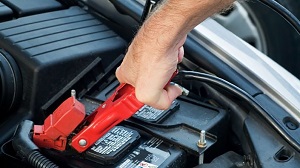4x4 Off Roading ›› Mechanical Problems ›› Repairs ›› Jump Start a Car
How to Jump Start a Car with Cables?
Knowing how to jump a car (e.g. using jumper cables) can save you time and expense if you ever get stuck with a flat battery (e.g. little or no voltage).
This step by step guide explains the complete process for jumping a car, including how to safely attach the jumper cables to the vehicle.
Using Booster Cables on a Dead Battery
So, your car battery died at the side of the road and you need some help to get it going again? One way to get the engine running in manual cars is to use a sudden release of the clutch while someone is pushing the vehicle.
But, if it's an automatic, you might need to jump-start it with jumper cables (assuming a good Samaritan with a vehicle is nearby).
Always check that you can use them on your make of vehicle and make sure you are using insulated, colour-coded jump leads for safety.
Hooking up the wires correctly means it won't affect vehicles with different grounds (e.g. one positive ground and one negative ground). It also means you can connect the boosters to a vehicle with an alternator even if the other has a generator.
Safety Check Prior to Jump Starting a Car
- Extinguish all naked flames (e.g. cigarettes).
- Inspect the battery and make sure it is not damaged or leaking.
- Remove the key from the ignition.
- Move any unnecessary metal items and clothing materials away from the batteries.
The steps below explain how to hook up the cables (using red and black crocodile clips) on both vehicles and in the correct manner.
- Usually, you will need access to another vehicle that has a charged battery. Most car repair and maintenance guides recommend you wear gloves and eye goggles for added protection.
- Position each car close together - with the bonnets of both vehicles facing one another. Place both cars in Park or Neutral, and engage both parking brakes.
- Shut off the ignitions, open the two bonnets, and make sure the jump leads reach both batteries. It is best to turn off the radio, unplug phone chargers, computers, and GPS system before connecting the booster cables in the correct order.
- First, attach one red crocodile clip to the positive terminal (+) of the dead battery. Positive battery terminals are usually bigger than negative (-) terminals. Then, connect the red clip at the other end of the same cable to the positive terminal post of the battery on the working car. Make sure the teeth grip both (+) terminals in a secure manner.
- Next, connect one of the black clips to the negative terminal on the working battery. Connect the remaining black clip to a solid piece of unpainted metal on the non-working car (not the terminal on the dead battery). Make sure it is connected to metal far away from the fuel system and the battery to reduce the risk of an explosion (e.g. the metal strut used to keep the bonnet open, or a specified earthing rod).
 Wait for a period of at least five (5) minutes after connecting both cables. Then, start the charged car and let the engine run for a few minutes. Leave the engine running and try to start the vehicle that has the flat battery.
Wait for a period of at least five (5) minutes after connecting both cables. Then, start the charged car and let the engine run for a few minutes. Leave the engine running and try to start the vehicle that has the flat battery.- If it doesn't start (e.g. within 5 to 10 seconds), wait a few minutes and try again. If it still doesn't start, you may need to buy a new car battery and dispose of the old one 'safely'.
- Once it starts, allowing the engine to run for about ten (10) minutes will help you determine if it's holding a charge. When removing the jump leads from the batteries, always disconnect them in reverse order.
- Driving the vehicle for thirty minutes or so should help to recharge the flat battery. If not, you may need to call for a recovery truck to tow your car to a garage.
You can buy two (2) jump leads in a set for less than £20 in the United Kingdom and store them in the car. One should be red in colour (positive) and the other should be black (negative).
You might also enjoy reading about...
- Basic engine maintenance guide and checklist for beginners
- Driving in river beds: Environment Agency warning for all motorists
- Off road vehicles for sale (free website adverts available)
Important: Using jump leads to start a car may cause damage to vehicles with electronic ignition systems and those running on alternative fuel. Hence, it is best to check the owner's manual before jump-starting a car with jumper cables.